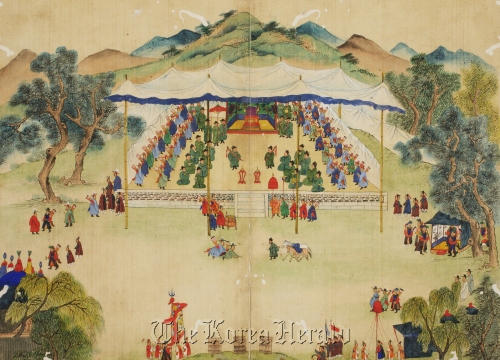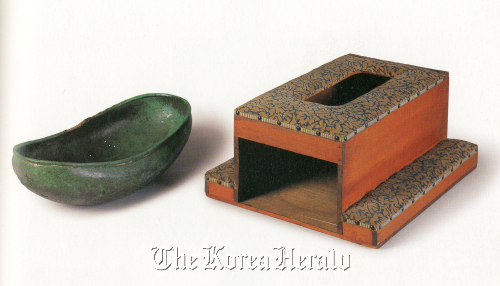Changdeokgung and its legacy featured by national museum
Among the five grand palaces that were built by the kings of the Joseon Dynasty (1392-1910), “Changdeokgung,” or Changdeok Palace, was favored by many members of the royal family.
The literal meaning of the palace, “Palace of Flourishing Virtue,” is reflected in Changdeokgung’s architecture and scenery, where the buildings are harmoniously blended with the natural environment surrounding them.
Celebrating the 50th anniversary of the Cultural Heritage Administration, the National Palace Museum of Korea is holding a special exhibition, “Changdeokgung: The Palace of Flourishing Virtue,” featuring the palace and its historical and cultural items, from June 28 to Aug. 28.
While the palace has been open to the public, the personal items owned by royal family members in Changdeokgung and other cultural relics were rarely shown in the past, the museum said.
The exhibition features some 100 artifacts and items that were used or created in the palace, including royal documents, exquisite paintings, and everyday living supplies.
Among the featured paintings, “Donggwoldo,” or “Painting of the Eastern Palace,” a 19th century painting of Changdeokgug and Changgyeonggung of Joseon, is a detailed bird’s-eye depiction of the two palaces.
“Donggwol,” meaning “Eastern Palace” was another name for Changdeokgung, as it was built in the east of “Gyeongbokgung,” the main palace of the Joseon Dynasty.
Another 19th century painting, “Illustration of the Civil Service and Military Examinations Inaugurated by King Myeongjong at Seochongdae,” offers a rare glimpse into what it was like to participate in a military exam in Changdeokgung in the king’s presence.
Among the five grand palaces that were built by the kings of the Joseon Dynasty (1392-1910), “Changdeokgung,” or Changdeok Palace, was favored by many members of the royal family.
The literal meaning of the palace, “Palace of Flourishing Virtue,” is reflected in Changdeokgung’s architecture and scenery, where the buildings are harmoniously blended with the natural environment surrounding them.
Celebrating the 50th anniversary of the Cultural Heritage Administration, the National Palace Museum of Korea is holding a special exhibition, “Changdeokgung: The Palace of Flourishing Virtue,” featuring the palace and its historical and cultural items, from June 28 to Aug. 28.
While the palace has been open to the public, the personal items owned by royal family members in Changdeokgung and other cultural relics were rarely shown in the past, the museum said.
The exhibition features some 100 artifacts and items that were used or created in the palace, including royal documents, exquisite paintings, and everyday living supplies.
Among the featured paintings, “Donggwoldo,” or “Painting of the Eastern Palace,” a 19th century painting of Changdeokgug and Changgyeonggung of Joseon, is a detailed bird’s-eye depiction of the two palaces.
“Donggwol,” meaning “Eastern Palace” was another name for Changdeokgung, as it was built in the east of “Gyeongbokgung,” the main palace of the Joseon Dynasty.
Another 19th century painting, “Illustration of the Civil Service and Military Examinations Inaugurated by King Myeongjong at Seochongdae,” offers a rare glimpse into what it was like to participate in a military exam in Changdeokgung in the king’s presence.


Everyday living supplies used by members of the royal family, including a Korean traditional caldron made of silver and a portable toilet used by the king, are being exhibited to the public for the very first time.
An item from “Uigwe,” a collection of royal protocols of Joseon, from the year 1647, is also included in the exhibition. The specific royal document chronicles the repairing process of Changdeokgung after it was partially damaged by a 1623 military coup d’etat.
The name plate of “Gyujanggak,” the royal library of Joseon which was located in Changdeokgung until 1910, was created in 1694. Visitors can witness the sophisticated brush stroke of King Sukjong’s handwriting, who wrote the name of the library for the plate.
Changdeokgung was first built in 1405 during the reign of Taejong, the third king of the Joseon Dyansty. It was designated a UNESCO world heritage site in 1997 for its harmonious blending with its natural surroundings which reflected Confucian philosophy and teachings ― that one should not go against the laws of mother nature.
“Changdeokgung is the palace that carries the spirit of Joseon the most,” the museum said in a statement.
“It is very Confucian, based on Joseon’s traditional values of ‘hyo,’ filial duty, and ‘ye,’ courtesy.”
Along with the exhibition, two special lectures on the history and culture of Changdeokgung will be held at the museum on July 4 and Aug. 11. Separate tours for children are also available.
For more information, call (02) 3701-7633-4, or visit www.gogung.go.kr.
By Claire Lee (dyc@heraldcorp.com)


![[AtoZ into Korean mind] Humor in Korea: Navigating the line between what's funny and not](http://res.heraldm.com/phpwas/restmb_idxmake.php?idx=644&simg=/content/image/2024/04/22/20240422050642_0.jpg&u=)
![[Exclusive] Korean military set to ban iPhones over 'security' concerns](http://res.heraldm.com/phpwas/restmb_idxmake.php?idx=644&simg=/content/image/2024/04/23/20240423050599_0.jpg&u=20240423183955)



![[Graphic News] 77% of young Koreans still financially dependent](http://res.heraldm.com/phpwas/restmb_idxmake.php?idx=644&simg=/content/image/2024/04/22/20240422050762_0.gif&u=)
![[Herald Interview] Why Toss invited hackers to penetrate its system](http://res.heraldm.com/phpwas/restmb_idxmake.php?idx=644&simg=/content/image/2024/04/22/20240422050569_0.jpg&u=20240422150649)





![[Exclusive] Korean military to ban iPhones over security issues](http://res.heraldm.com/phpwas/restmb_idxmake.php?idx=652&simg=/content/image/2024/04/23/20240423050599_0.jpg&u=20240423183955)



![[Today’s K-pop] Ateez confirms US tour details](http://res.heraldm.com/phpwas/restmb_idxmake.php?idx=642&simg=/content/image/2024/04/23/20240423050700_0.jpg&u=)